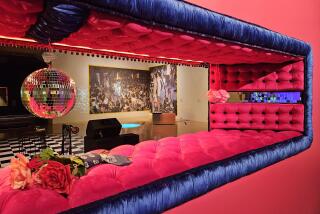Louise Sandhaus digs into California graphic design history at L.A.’s Municipal Art Gallery
- Share via
WHEN CalArts faculty member Louise Sandhaus pondered West Coast design history for a book proposal five years ago, she theorized that California’s freewheeling graphics sensibility might be directly connected to the very ground we stand, slip and slide on.
Explaining her project-in-progress “Earthquakes, Mudslides, Fires and Riots: California and Graphic Design,” Sandhaus says, “Half-seriously, I began thinking in my crackpot imagination that graphic designers here don’t stick to tradition because the ground isn’t firm enough. These great shifts might be connected to disaster, but earthquakes, mudslides, fires and civil uprisings also produce change.”
Page spreads from Sandhaus’ “Earthquakes” proposal, encompassing posters, magazine ads, book covers and fonts created between 1935 and 1985, are on display through July 13 at Barnsdall Park’s Municipal Art Gallery.
The images illustrate how West Coast designers figuratively shook up the New York-centric graphics establishment. For example, “Earthquakes” essayist Lorraine Wild writes that 35 years ago, the color orange was simply “not used by serious designers on the East Coast.” John Van Hamersveld blithely ignored that bias with his “The Endless Summer” movie poster (1964), which deployed hyper-saturated blasts of orange and yellow to evoke sunny SoCal surf culture.
Bay Area hippie communes produced Do It Yourself period pieces such as the Diggers’ “1% Free” poster (1968) and the crude but vibrant hand-drawn cover art for “Kaliflower” (1971). Says Sandhaus, “In these works you pick up on this feeling of creativity spurred on by drugs and possibility: ‘We can remake the world and we can do it our way.’ ”
That renegade spirit was also championed by computer graphics pioneer April Greiman, who shocked peers in 1986 when Design Quarterly magazine published her nude self-portrait as a fold-out poster. Sandhaus recalls, “A lot of tongues were wagging when April’s poster came out. For a designer to take herself as the subject, showing herself naked? That just wouldn’t happen in New York or Europe. It was outrageous.”
--
Hugh Hart
More to Read
The biggest entertainment stories
Get our big stories about Hollywood, film, television, music, arts, culture and more right in your inbox as soon as they publish.
You may occasionally receive promotional content from the Los Angeles Times.










